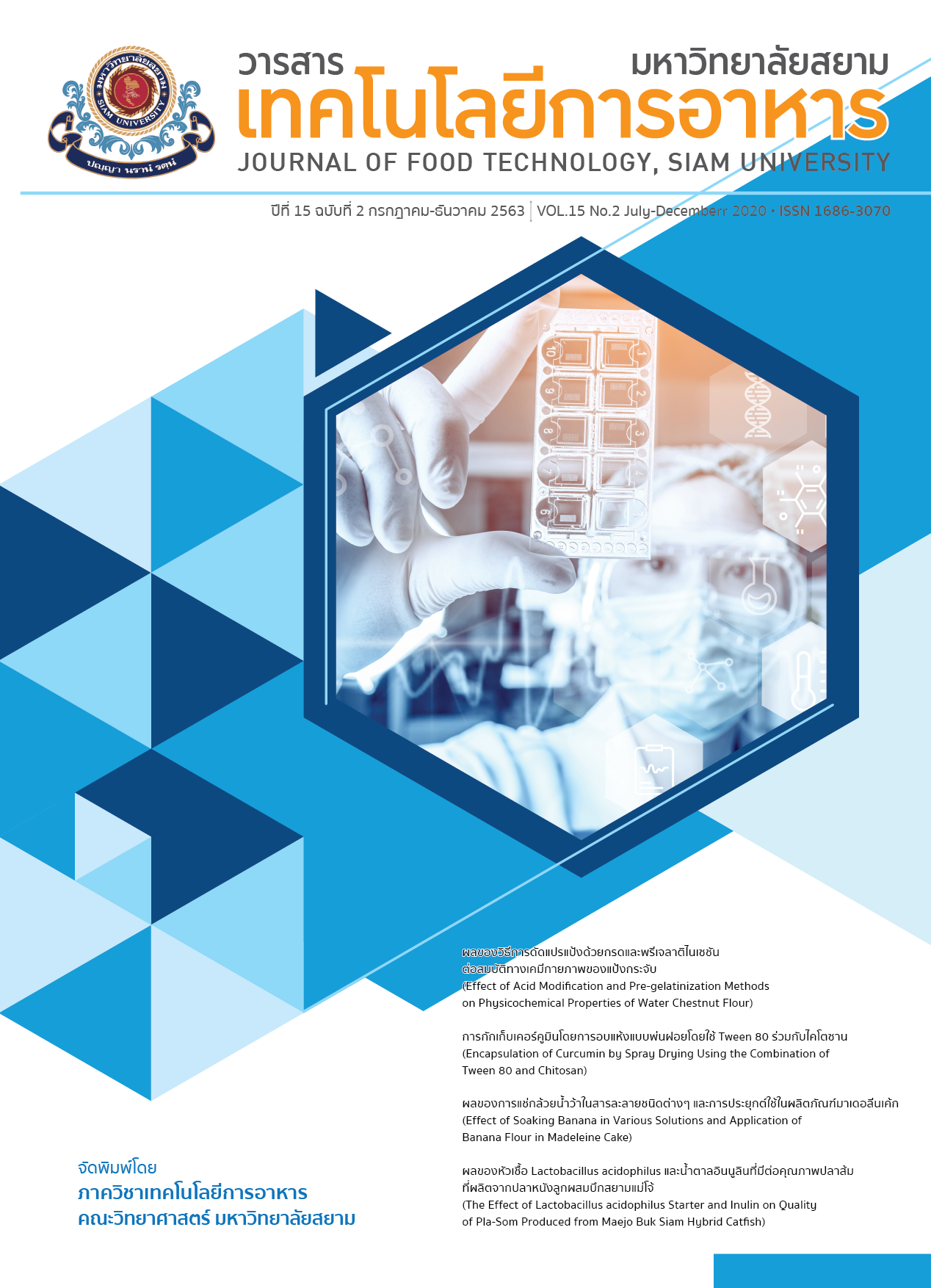Mechanisms of Maillard Browning Reduction of Whey Protein Hydrolysate Powder in Sterilized Protein Products
Main Article Content
Abstract
This research investigated the mechanisms in the reduction of Maillard browning reactions of whey protein hydrolysate powder (WPH) prepared by hydrolysis of whey protein concentrate (WPC) with trypsin (E.C.3.4.21.4) at 37 °C for 60 min and spray-dried with trehalose when used in the mixed solutions containing protein 1.3 % (w/v) from WPC 1.0 % and WPH 0.3 %, added with lactose 0 – 0.25 mol L-1, and sterilized at 121 °C for 15 min. The mechanisms of browning reduction of reconstituted WPH powder involved the increasing antioxidant activities of WPH, assessed by oxygen radical absorbance assay and ABTS·+ radical scavenging capacity assay of the short-chain peptides of less than 6.5 kDa. Besides, the thiol groups played an essential role in reducing the occurrence of brown melanoidin pigments, probably by directly involved in the Maillard reactions that generated fluorescent products or donating the hydrogen atom to the free radicals, and subsequently transforming to stable intermediates, thus suppressing the formation of brown pigments in full Maillard reactions of protein – lactose solutions subjected to sterilization.
Article Details
Copyrights of all articles in the Journal of Food Technology available in print or online are owned by Siam University and protected by law.
References
Nacka, F., Chobert, J., Burova, T., Leonil, J. and Haertle, T. (1998). Induction of new physicochemical and functional properties by the glycosylation of whey proteins. Journal of Protein Chemistry. 17(5): 495–503.
De Block, J., Merchiers, M., Mortier, L., Braekman, A., Ooghe, W. and Van Renterghem, R. (2003). Monitoring nutritional quality of milk powders: capillary electrophoresis of the whey protein fraction compared with other methods. International Dairy Journal. 13(2-3): 87–94.
Jing, H. and Kitts, D.D. (2002). Chemical and biochemical properties of casein – sugar Maillard reaction products. Food Chemistry and Toxicology. 40(7): 1007–1015.
Hongsprabhas, P., Kerdchouay, P. and Sakulsom, P. (2011). Lowering the Maillard Reaction Products (MRPs) in thermally processed foods and their cytotoxicity in human cell models by whey protein hydrolysate. Food Research International. 44(3): 748–754.
Hodge, J.E. (1953). Chemistry of browning reactions in model systems. Journal of Agricultural and Food Chemistry. 1: 928–943.
Goldin, A., Beckman, J.A., Schmidt, A. and Creager, M.A. (2006). Advanced glycation end products sparking the development of diabetic vascular injury. Journal of American Heart Association. 114(6): 579–605.
Schamberger, G.P. and Labuza, T.P. (2007). Effect of green tea flavonoids on Maillard browning in UHT milk. LWT Food Science and Technology. 40(8): 1410–1417.
Totlani, V.M. and Peterson, D.G. (2007). Influence of epicatechin reactions on the mechanisms of Maillard product formation in low moisture model system. Journal of Agricultural and Food Chemistry. 55(2): 414–420.
Elias, R.J., Kellerby, S.S. and Decker, E.A. (2008). Antioxidant activity of proteins and peptides. Critical Review in Food Science and Nutrition. 48(5): 430–441.
Tong, L.M., Sasaki, S., McClements, D.J. and Decker, E.A. (2000). Mechanisms of the antioxidant activity of a high molecular weight fraction of whey. Journal of Agricultural and Food Chemistry. 48(5): 1473–1478.
Rongsirikul, N. and Hongsprabhas, P. (2016). Brown pigment formation in heated sugar-protein mixed suspensions containing unmodified and peptically modified whey protein concentrates. Journal of Food Science and Technology. 53(1): 800–807.
Korhonen, H. and Pihlanto, A. (2006). Bioactive peptides: Production and functionality. International Dairy Journal. 16(9): 945 – 960.
Samaranayaka, A.G.P. and Li-Chan, E.C.Y. (2011). Food-derived peptidic antioxidants: A review of their production, assessment, and potential applications. Journal of Functional Foods. 3: 229–254.
Olsen, J.V., Ong, J.S.E. and Mann, N. (2004). Trypsin cleaves exclusively C-terminal to arginine and lysine residues. Molecular Cell Proteomics. 3(6): 608–614.
AOAC. (2000). Official Methods of Analysis (17th ed.), Gaithersburg, MD, USA: The Association of Official Analytical Chemists.
Laemmli, U.K. (1970). Cleavage of structural proteins during assembly of head bacteriophage T4. Nature. 227: 680–685.
Jain, N.K. and Roy, I. (2008). Effect of trehalose on protein structure. Protein Science. 18(1): 24–36.
Nielsen, P.M., Petersen, D. and Dambmann, C. 2001. Improved method for determining food protein degree of hydrolysis. Journal of Food Science. 66(5): 642–646.
Beveridge, T., Toma, S.T. and Nakai, S. (1974). Determination of SH- and SS- group in some food proteins using Ellman’s reagent. Journal of Food Science. 39(1): 49–51.
Prior, R.L., Hoang, H., Gu, L., Wu, X., Bacchiocca, M., Howard, L., Hampsch-Woodill, M., Huang, D., Ou, B. and Jacob, R. (2003). Assays for hydrophilic and lipophilic antioxidant capacity (oxygen radical absorbance capacity (ORACFL)) of plasma and other biological and food samples. Journal of Agricultural and Food Chemistry. 51: 3273–3279.
Dávalos, A., Gomez-Cordoves, C. and Bartolomè, B. (2004). Extending applicability of the oxygen radical absorbance capacity (ORAC-Fluorescein) assay. Journal of Agricultural and Food Chemistry. 52(1): 48–54.
Re, R., Pellegrini, N., Proteggente, A., Pannala, A., Yang, M. and Rice-Evans, C. (1999). Antioxidant activity applying an improved ABTS radical cation decolorization assay. Free Radical Biology & Medicine. 26: 1231–1237.
Rozycki, S.D., Buera, M.P., Piagentini, A.M., Costa, S.C. and Pauletti, M.S. (2010). Advances in the study of the kinetics of color and fluorescence development in concentrated milk systems. Journal of Food Engineering. 101(1): 59–66.
Pan, G.G. and Melton, L.D. (2007). Nonenzymatic browning of lactose and caseinate during dry heating at different relative humidities. Journal of Agricultural and Food Chemistry. 55(24): 10036–10042.
Cheison, S.C., Leeb, E.L., Toro-Sierra, J. and Kulozik, U. (2011). Influence of hydrolysis temperature and pH on the selective hydrolysis of whey proteins by trypsin and potential recovery of native alpha-lactalbumin. International Dairy Journal. 21(3): 166–171.
Mota, M.V.T., Ferreira, I.M.P.L.V.O., Oliveira, M.B.P., Rocha, C., Teixeira, J.A., Torres, D., Gonçalves, M.P. (2006). Trypsin hydrolysis of whey protein concentrates: Characterization using multivariate data analysis. Food Chemistry. 94:278-286.
Zeng, J. and Davies, M.J. (2006). Protein and low molecular mass thiols as targets and inhibitors of glycation reactions. Chemical Research in Toxicology. 19(12): 1668–1676.


